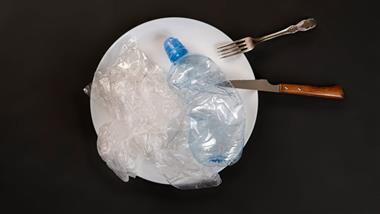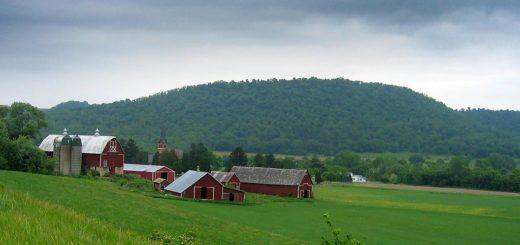Plastics Pollution is Out of Control
Scientists Want to Create Tasty Food From Plastic
Analysis by Dr. Joseph MercolaFact Checked
- October 17, 2020

STORY AT-A-GLANCE
- DARPA has granted $2.7 million to start a project to create a food system using military plastic and paper waste to improve military logistics
- The initial intent is to use waste products for food to reduce supplies needed on missions; however, in a world where the Impossible Burger is embraced, it’s not likely to stop there
- The world has a plastic pollution problem, but only 9% of the plastic created since 1950 has been recycled
- Consider joining the fight against plastic pollution through legislative efforts and a personal commitment to cut back on the amount of plastic you use daily
We have a problem with plastic. Not only is it difficult to get rid of without damaging the environment, but we appear to have an addiction to all things disposable. In the U.S., plastic is considered an integral and necessary part of daily life. Just a stroll down the grocery store aisle reveals an unhealthy dependence on plastic, from packaging to bags for our groceries.
Fresh produce is often wrapped in plastic or sliced and shrink-wrapped in a plastic covering. Nuts, cheese, milk and lettuce are all encased in plastic. Across the world, 299 million tons were produced in 2013, much of which ended up in the oceans, threatening wildlife and environment.1 In 2015, the U.S. generated 34.4 million tons, which accounted for 13.2% of municipal solid waste.2
In the case of plastic packaging, 95% of the material value, an estimated $80 billion to $120 billion annually, is lost after its first usage, adding economic problems to other drawbacks, according to a report from the World Economic Forum.3 Now scientists are thinking about how to make plastic into food.
Exchanging Plastic for Food
With a focus on improving military logistics, the Defense Advanced Research Projects Agency (DARPA) awarded Iowa State University and partners a $2.7 million grant to make food from plastic and paper waste, which they intend to feed to military men and women.4 The ability to turn paper and plastic into a food product may help with short-term nourishment for soldiers and improve military logistics for extended missions.
They estimate the total grant award may reach $7.8 million before the project ends. Partners in this endeavor include the American Institute of Chemical Engineers RAPID Institute, the University of Delaware and Sandia National Laboratories. Initially, the system is being called the Novel Oxo-degradation to Macronutrients for Austere Deployments (NOMAD).
The aim is to convert paper waste into sugars and plastic into fatty acids and fatty alcohols. These byproducts would then be processed into a single cell biomass in the field. Other examples of single cell proteins include Vegemite and nutritional yeast. The NOMAD system must fit specific requirements to enable military troops to carry it with them during deployment and extraction.
While DARPA is initiating the project for use by the military in the field, it may not be long before such a system would be proposed as a means of providing inexpensive food stuffs for others. As explained in the press release from Iowa State University, the process could “go a long way toward solving looming problems of plastic disposal and ensuring a viable global food chain.”5
Robert Brown from Iowa State University is the principal investigator on the project. He explained how plastics and paper could biodegrade in the field and be used to grow edible yeast or bacteria:6
“When exposed to heat or ultraviolet light in the presence of oxygen, plastics convert to oxygenated compounds that can be consumed by microorganisms — plastics are, in fact, bio-degradable, but the process is very slow, as evidenced by the accumulation of plastic wastes in the environment.
We can dramatically increase oxo-degradation of plastics to fatty compounds by raising the temperature a few hundred degrees Fahrenheit. The cooled product is used to grow yeast or bacteria into single cell proteins suitable as food.”
‘An Army Marches on Its Stomach’
This familiar saying has been attributed to Napoleon and Fredrick the Great in reference to the ability of an army to perform better when their nutritional needs are met.7 While an argument could be made the food supplied to the military would be “natural” single cell protein, it’s important to remember the lessons that we have learned from grain-fed beef.
There are multiple problems with raising livestock in concentrated animal feeding operations (CAFOs), including issues with the environment, water supply, humane treatment of the animals and the addition of chlorine and other toxins to clear away contaminants. Despite the outcry over CAFOs, many fall back to the claim that factory farms can feed the world. The question is — at what cost?
As nutritional analyses have revealed, issues inside the CAFOs and surrounding communities are not the only problems. The nutritional differences in beef raised or finished on grain versus beef from pasture raised animals is striking. Grass fed beef has better fatty acid composition and antioxidant content.8
The meat is higher in conjugated linoleic acid (CLA) and precursors to CLA,9 which play a role in fat metabolism and positively modify cardiometabolic risk factors which impact body composition by lowering body fat levels.10 Grass fed beef is also higher in omega 3 fats and lower in cholesterol elevating fats.11
The aim of producing more meat in less time with less effort has led to a glut on the market of beef that contributes to the ill health of those who eat it. Ronnie Cummins from the Organic Consumers Association says it best in this article:
“Before these hapless creatures are dragged away to hell, to be fattened up on GMO grains and drugged up in America’s CAFOs, their meat is high in beneficial omega-3 and conjugated linoleic acids (CLA), and low in ‘bad’ fats.
Unfortunately by the time their abused and contaminated carcasses arrive, all neatly packaged, at your local supermarket, restaurant, or school cafeteria, the meat is low in omega-3 and good “fats,” and routinely tainted by harmful bacteria, not to mention pesticide, steroid, and antibiotic residues.”
The lesson learned is that just because it looks like healthy beef, doesn’t mean it carries the same nutritional value as that raised in a healthy environment. Of course, the same can be said about Impossible Burgers or any other food product manufactured in the lab. In the short term it may be a solution to a military problem, but do you think it will stop there?
Is Recycling Just a Big Fraud?
Recycling is another way of attempting to reduce the problem with plastic pollution. However, the question remains as to whether this is a viable answer since there is growing evidence suggesting it may have only a minor impact under the best of circumstances.
The Guardian12 reports that Earth Island Institute filed a lawsuit against 10 major companies. The group hopes to force the organizations to take responsibility and pay for the environmental and ecological destruction their products are causing. Ramping up recycling may sound like an answer, but as the executive director of the Basel Action Network, Jim Puckett, told Rolling Stone magazine:13
“They really sold people on the idea that plastics can be recycled because there’s a fraction of them that are. It’s fraudulent. When you drill down into plastics recycling, you realize it’s a myth.”
Pucket goes on to describe how 91% of the plastic created since 1950 has never been recycled, quoting a study published in 2017.14 In addition, the reporter from Rolling Stone, Tim Dickinson, wrote:15
“Unlike aluminum, which can be recycled again and again, plastic degrades in reprocessing, and is almost never recycled more than once. A plastic soda bottle, for example, might get downcycled into a carpet.”
At the rate at which plastic is being added to the ocean, it’s expected there will be more plastics than fish by 2050.16 You’ll find more about plastic recycling, struggles with landfill pileup and Coca-Cola undermining the recycling efforts in “Is Plastic Recycling Just a Big Fraud?”
Lifetime Average Consumption of Plastic Is Shocking
Tiny bits of plastic can be found nearly everywhere in the environment, including the food on your plate. Microplastics, as they are called, are smaller than 5 mm and have been found in foods and beverages. Drinking water is one of the largest sources from which researchers estimate the average person consumes 1,769 particles each week.17
Yet, bottled water is not the solution since it may contain even more plastic than tap water. Research published in Environmental Science and Technology suggested people who drink bottled water exclusively may consume more microplastics than those who drink tap water:18
“Additionally, individuals who meet their recommended water intake through only bottled sources may be ingesting an additional 90,000 microplastics annually, compared to 4,000 microplastics for those who consume only tap water.”
Plastic pollution likely originates from the manufacturing process of bottles and caps. When researchers tested 259 bottles of 11 bottled water brands, they found there were 325 pieces of microplastic per liter, on average.19 The brands tested included Aquafina, Evian, Dasani, San Pellegrino and Nestle Pure Life, among others.
Based on the findings from the WWF International study, Reuters created an illustration showing how much plastic a person would consume over time. According to these estimations, you may be consuming:20
- Every week — 5 grams or enough plastic to pack a soup spoon.
- Every six months — 125 grams or enough shredded flakes to fill a cereal bowl.
- Every year — 250 grams or a heaping dinner plate of shredded plastic.
- Every 10 years — 2.5 kg (5.5 pounds) or about the size of a standard life buoy.
- Over 79 years — 20 kg (44 pounds) of shredded plastic over an average lifetime.
To put this in perspective, one car tire weighs about 20 pounds.21 So a lifetime supply of plastic consumption would be like slowly eating 2.2 car tires. Thava Palanisami of the University of Newcastle, who was involved in a study conducted by the World Wildlife Fund (WWF), told Reuters:22
“We have been using plastic for decades but we still don’t really understand the impact of micro- and nano-sized plastic particles on our health … All we know is that we are ingesting it and that it has the potential to cause toxicity. That is definitely a cause for concern.”
A Call to End Plastic Pollution
The fight against plastic pollution is being carried out on several fronts. In addition to the lawsuit filed by Earth Island Institute, the WWF is calling on governments to support further research into the consequences on living organisms when microplastics are ingested. In their analysis, they note:23
“The current global approach to addressing the plastic crisis is failing. Governments play a key role to ensure all actors in the plastic system are held accountable for the true cost of plastic pollution to nature and people.”
You can help by supporting legislation that is aimed at holding companies accountable for the pollution they create. For example, New Mexico Sen. Tom Udall introduced the Break Free From Plastic Pollution Act of 2020, which requires companies selling plastic products to pay for “end-of-life” initiatives that ensure plastic does not end up polluting the environment.24
Bills like this need your support since the industry has deep pockets and its players are notorious for their extensive lobbying and public relations expertise. It’s also important to remember the significant impact you can have by making simple changes in your daily life. Below is a sampling of strategies that can help:
| Don’t use plastic bags. Opt for reusable bags, especially for groceries |
| Bring your own mug for a coffee drink; skip the lid and straw |
| Instead of buying bottled water, bring water from home in a glass water bottle |
| Make sure the items you recycle are actually recyclable |
| Store foods in glass containers or Mason jars, not plastic containers or freezer bags |
| Bring your own leftovers container when eating out |
| Avoid processed foods, which are typically sold with plastic wrapping or plastic-lined paper boxes. Buy fresh produce and use vegetable bags brought from home |
| Request no plastic wrap on your newspaper and dry cleaning |
| Use nondisposable razors, cloth diapers and rags. (Old shirts and socks make great cleaning rags) |
| Avoid disposable utensils and straws and buy foods in bulk when you can |
| Buy clothes and other items at secondhand stores. Microfibers found in newer clothing can be as destructive as plastic grocery bags |
| Buy infant toys and even pet toys made of wood or untreated fabric, not plastic |
+ Sources and References Previous ArticleCoronavirus Fraud Scandal — The Biggest Fight Has Just BegunView More Show Comments (8)Post your commentWINTER IS COMING
How to Stop a Second Wave of COVID-19Learn More
By continuing to browse our site you agree to our use of cookies, revised Privacy Policy and Terms of Service.
Subscribe to the FREE #1 Natural Health Newsletter


![Rothschild’s PG & E’s Genocide Documents-Murder IS Legal [Time to Get OFF the Grid]](https://brutalproof.net/wp-content/themes/hueman/assets/front/img/thumb-medium-empty.png)








